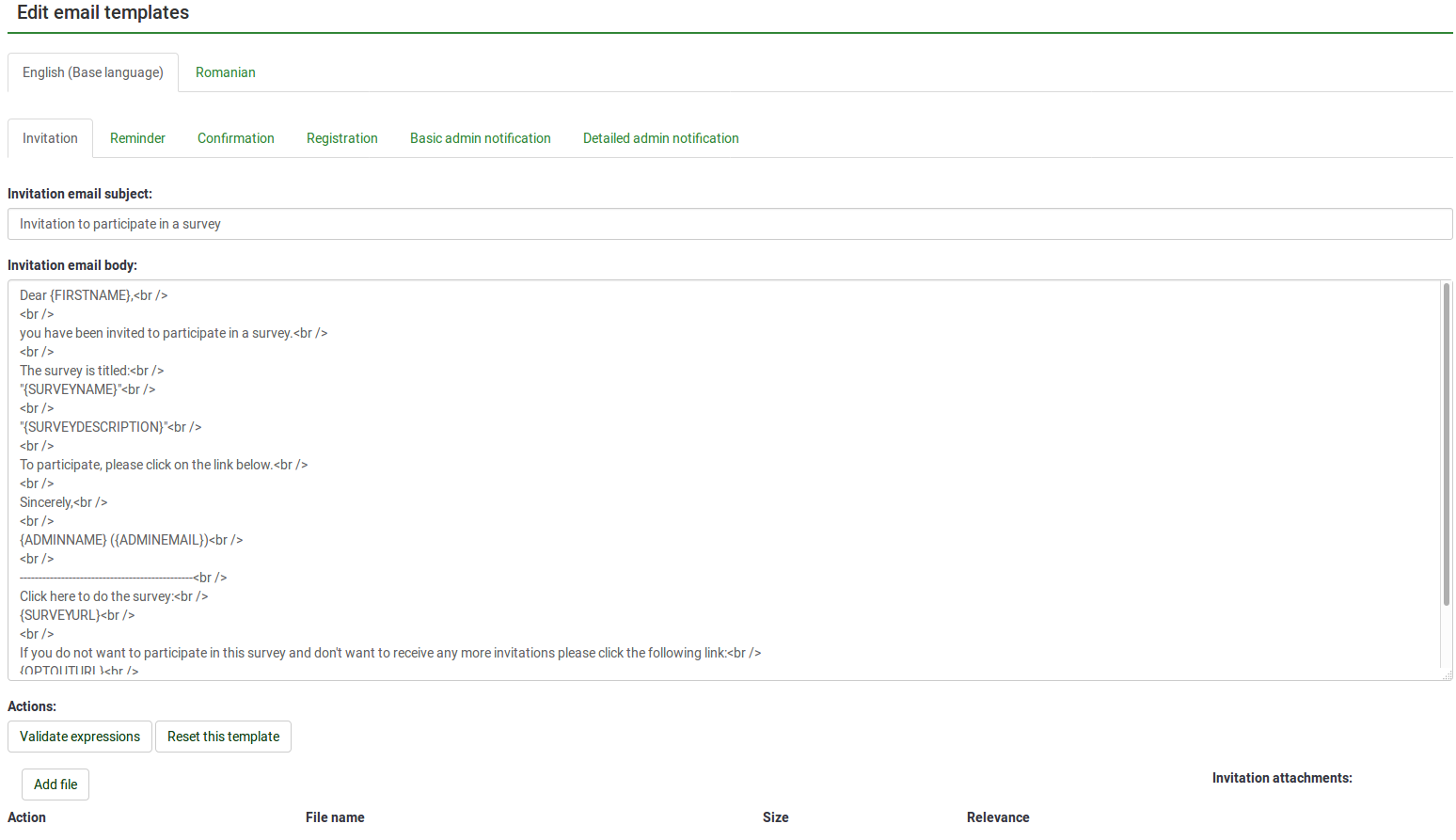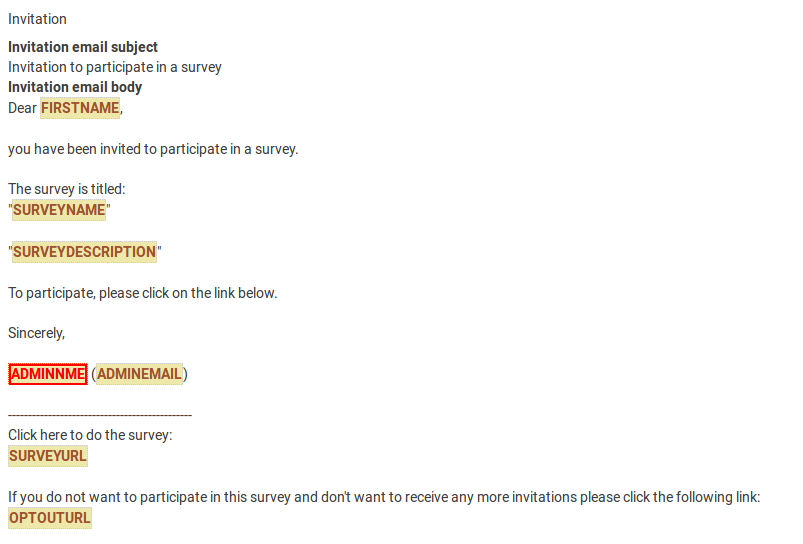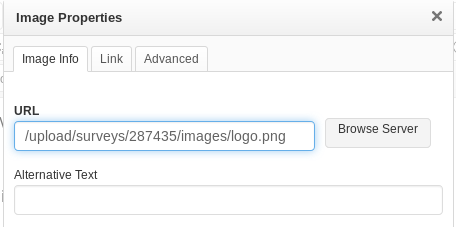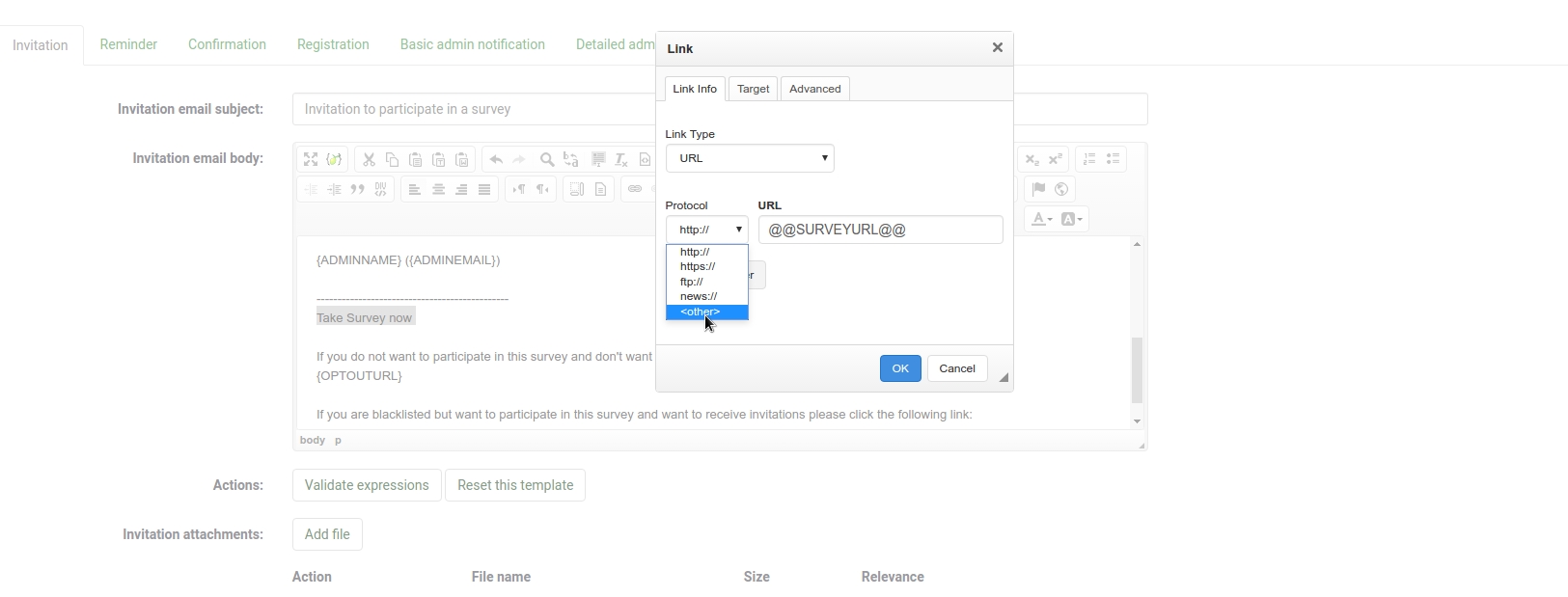Modèle de courriel
From LimeSurvey Manual
Introduction
Les modèles d'emails sont utilisés pour envoyer rapidement des invitations personnalisées, des rappels, des mails d'inscriptions à vos correspondants (depuis le tableau des participants à l'enquête). Vous pouvez également modifier les notifications d'administration standard de base (ou détaillées) envoyées aux administrateurs de l'enquête.
Pour y accéder, allez dans paramètres du questionnaire et cliquez sur modèles d'email tab:
Email Templates Panel
Pour modifier les modèles d'e-mail, sélectionnez l'entrée correspondante du menu questionnaire

Comme nous pouvons le voir sur la capture d'écran, la "source HTML" le mode éditeur est utilisé. Pour le changer, vérifiez votre paramétrage du compte personnel.
Comme vous pouvez le voir, 5 types d'emails peuvent être envoyé aux utilisateurs et administrateur(s) :
Invitation
Le système d'invitation est utile quand vous souhaitez envoyer des mails en vrac à tous les répondants de votre Table des participants au questionnaire qui n'ont pas encore reçu une invitation pour compléter votre questionnaire.
From the email templates panel, you can edit the message sent to survey participants. To check which email placeholders can be used, continue reading the following wiki subsection. You can also use the ExpressionScript to further customize your invitation email template.
Rappel
Le système de rappel aide les administrateurs à rappeler à leurs participants depuis la table des participants au questionnaire à répondre.
You can edit the default format of the reminder email from the Email templates panel. To verify which email placeholders can be used, continue reading the following wiki subsection. The ExpressionScript can help you customize the text body of this email template.
Confirmation
If tokens are used and a participant fills out the survey, a confirmation email will be sent to his/her email address. You can deactivate this functionality from the Participant settings panel.
Click the Confirmation tab if you want to edit the email template. Check the email placeholders to see which ones can be used in this type of email. You may also use the ExpressionScript to customize your email.
Enregistrement
If closed-access mode is enabled (there is a survey participants table, which means that only those participants who have an allocated entry and a unique token code associated to it can complete the respective survey. If you allow participants to publicly register to your survey, a new entry in your survey participants table will be created once the respondent has submitted his or her name and email address. A script that runs in the background will automatically send the respective respondent a registration email. It contains the URL with the token that needs to be accessed by the newly registered user.
Cliquez sur l'onglet enregistrement pour éditer le format de cet email. N'oubliez pas de regarder en premier quel Espace réservé au mail peut être utilisé à l'intérieur du corps du texte. Le Gestionnaire d'expression peut fournir plusieurs customisations au corps du texte vous souhaitez utiliser.
Notifications d'administrateur basiques & détaillées
Pour atteindre les notifications d'administration, cliquez sur l'onglet de Management des données et écrivez-y une adresse email dans le "envoyer un email de notification d'administration de base à" et un autre (ou le même) dans le champs "envoyer un email de notification d'administration détaillé à".
Par défaut, la seule différence entre les deux est liée au surplus d'espace réservé {ANSWERTABLE} qui est inclus dans le modèle détaillé d'email de notification d'administration. Cela permet à l'utilisateur qui reçoit ce type d'email d'aussi vérifier les réponses soumises sans qu'il ai besoin d'accéder à l'installation de LimeSurvey.
Toutefois, en utilisant le gestionnaire d'expression et le espace réservé au mail vous pouvez customiser ces deux modèles de mail chaque fois que vous le voulez.
Email Templates Fields
Chaque modèle de mail contient :
- Le sujet du mail: Le titre du mail / un lot de mails que vous voulez envoyer;
- Le corps du mail: C'est une zone de texte qui contient le message que vous souhaitez envoyer aux utilisateurs. Il peut contenir du texte, des images et espace réservé au mail. De plus, le gestionnaire d'expression peut être utilisé pour encore améliorer le message que vous voulez délivrer.
- Email actions: Two actions are available:
- Reset this template: Once clicked, the HTML code is reset. No text is deleted;
- Validate expressions: Checks the logic of the email - whether the placeholders are correctly used or not. We highly recommend using it before sending a batch of emails. This way you can see whether the placeholders are correctly defined or not. In the below example, a small typo exists - it is emphasized in red.

Email Placeholders
In the default email templates, different email placeholders are used either in the body and/or the subject of the email. Their role is to connect the email you want to send to each participant in your survey participants list. The data from the survey participants table (e.g., email, first name, last name, token, etc.) is automatically taken and put into different unique emails before being sent to each participant from your survey participants list.
Below are the email placeholders that can be used within the body message of your invitation and reminder email templates. When sending out the emails, these email placeholders will be replaced in the preview of your invitation/reminder email with data from your survey and survey participants table.
| {ADMINEMAIL} | Email of the Survey admin |
| {ADMINNAME} | Name of Survey Admin |
| {SURVEYNAME} | Title of your survey |
| {SURVEYDESCRIPTION} | Description of your survey |
The following placeholders are allowed in invitation/reminder email templates (subject and/or body fields) and they will be replaced when sending out the emails:
| {EMAIL} | Email of the recipient |
| {FIRSTNAME} | First Name |
| {LASTNAME} | Last Name |
| {SURVEYURL} | The URL to start the survey - if you are sending HTML emails, a full URL will be displayed to the survey participant |
| @@SURVEYURL@@ | The URL to start the survey - this is the barebone link. Use this if you want to integrate the link in your custom HTML elements somewhere (available in v1.90 and later) |
| {OPTOUTURL} | The URL to deactivate sending of emails for the respective survey - a full link will be displayed in the HTML version of the email template |
| {OPTINURL} | If a user is blacklisted and wants to participate in the respective survey, they have to click the opt-in URL to receive survey invitations/reminders again. |
| {TOKEN} | The token to access the survey |
| {USESLEFT} | The number of uses left for the token |
| {VALIDFROM} | The date the token is valid from |
| {VALIDUNTIL} | The date the token is valid until |
| {ATTRIBUTE_1} | Attribute 1 |
| {ATTRIBUTE_2} | Attribute 2 (...and so on for more attribute fields) |
If your survey is not anonymous, the email placeholders can be used in order to add specific entry/participant data into the Survey text elements panel (e.g., survey description, welcome message, end message).
| {TOKEN:EMAIL} | Displays the email of the participant from the survey participants table |
| {TOKEN:FIRSTNAME} | Displays the first name of the participant from the survey participants table |
| {TOKEN:LASTNAME} | Displays the last name of the participant from the survey participants table |
| {TOKEN} | Displays the token code of the participant from the survey participants table |
| {TOKEN:ATTRIBUTE_1} | Displays "Attribute 1" of the participant from the survey participants table |
| {TOKEN:ATTRIBUTE_2} | Displays "Attribute 2" of the participant from the survey participants table (and so on for more attribute fields) |
These email placeholders can also be used in the confirmation and admin notification email templates.
Certain placeholders can be used only within the the admin notification templates. Please note that one email per response will be sent to the email address of the administrator!
Certains espaces réservés qui peuvent être utilisés uniquement dans le panel de notifications de l'administrateur sont mentionnés ci-dessous :
| {VIEWRESPONSEURL} | Displays an URL that redirects you to the respondent's submitted answer |
| {EDITRESPONSEURL} | Displays an URL that redirects you to a LimeSurvey page from where you can edit the responses submitted by the respective survey participant |
| {STATISTICSURL} | Click this URL to access the statistics of the survey |
| {ANSWERTABLE} | If you want to display the submitted answers of the participant in the admin notification email, use this email placeholder. This way, you no longer need to access your LimeSurvey installation in order to check the submitted answers of the respective respondent (as the {VIEWRESPONSEURL} placeholder does). |
- If your survey is using anonymized responses, then token-related placeholders will not work in the notification email template.
- You can use ExpressionScript to use expressions for tailoring an email (New in 1.92 ). Please have a look at the ExpressionScript how-tos for an example.
- Also have a look at the examples on using Information from survey participants table.
Participant Opt-out
When you use the {OPTOUTURL} tag in your invitation/reminder email, your participants can opt out of this particular survey by clicking the related URL in the email - so you don't send them reminder emails. A participant that opts out of your survey will have the email status 'OptOut' set in the survey participants list.
Barebone URL
URL placeholders have their corresponding Barebone URL. E.g., @@SURVEYURL@@: you can use @@OPTOUTURL@@, @@OPTINURL@@ …
En utilisant la fonction de remplacement.
Quelques mots-clés spécifiques peuvent être utilisés dans vos modèles de mail. Par exemple, certains mots-clés peuvent être utilisés pour remplacer l'adresse URL du jeton.
Un bon exemple est l'utilisation d'un lien vers le questionnaire au lieu d'une adresse longue.
Exemple : créer un lien sympa pour commencer le questionnaire
- d'abord ouvrez l'éditeur de modèles de courrier et choisir "invitation" dans les onglets du haut
- ensuite tapez le texte que vous voulez voir apparaître en tant que lien pour lancer le questionnaire
- ensuite sélectionnez ce texte

- ajoutez @@SURVEYURL@@ dans l'espace réservé pour le lien et choisissez "autre" dans le menu déroulant
2) Écrivez le texte que vous voulez voir apparaitre comme un lien pour commencer le questionnaire.
3) Ensuite sélectionnez ce texte.
4) Add the placeholder for the plain link @@SURVEYURL@@ and choose other from the protocol-select-box.
Maintenant, si vous envoyez votre e-mail d'invitation, le lien pour lancer le questionnaire sera un lien et non une url.
Email Attachments
File Actions
When clicking Add file the following window will be displayed asking you to choose the document from the files folder that you want to send via email:
Attachments can be added at the bottom of the email template editing interface. Please note that email attachments are uploaded on a per survey basis.
You can also upload, on the spot, a file from the desktop to your LimeSurvey installation by clicking the upload button and then selecting the file you want to attach to the respective email template.
Once selected, double click it and the file will be immediately displayed in the Files table, below the Add File button:
To have it permanently attached to the respective email template, do not forget to click the Save button located in the upper-right part of the window.
To determine if an attachment should be sent on an individual basis, it is possible to add a relevance equation to each attachment.
All functions supported by the ExpressionScript can be used, as well as token attributes if the survey uses tokens.
With notification or confirmation templates, it is also possible to use question codes used in the survey.
If you want to delete a file, click the red trash button located under the Action column and save the changes.
- When a file can not be found on the file system, the email will be sent without an attachment.
- Exporting/importing a survey does not export/import the attached uploaded files. However, the settings for attachments will be maintained, as well as the relevance equations.
Image Attachment
You can attach an image/images if you send HTML emails. To do this, you need to update the URL source of the image by settings its path to your public directory of your LimeSurvey instance.



